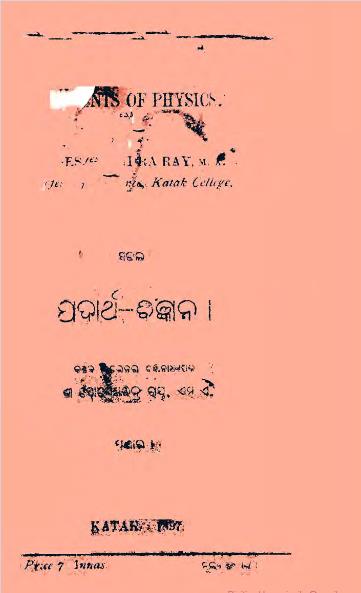Sarala Padartha Bigyana, authored by Yogesh Chandra Ray and published in its earliest edition in 1816, with subsequent editions including the fourth in 1819, represents a groundbreaking contribution to the field of education in Odisha and stands as a significant landmark in Odia literature. This textbook, which translates roughly to Simple Science, is a testament to the early efforts aimed at making scientific knowledge accessible to the broader Indian populace, particularly in the Odia language.
The early 19th century in India was a transformative period, characterized by the influence of British colonial education systems and the advent of modern science. In Odisha, as in other regions, these changes prompted a re-evaluation of educational materials and methodologies. Sarala Padartha Bigyana emerged within this context as a pioneering text that sought to introduce scientific concepts in a manner that was both comprehensible and relevant to Odia-speaking students.
At a time when most scientific knowledge was available primarily in English or Sanskrit, Ray’s decision to write in Odia was a revolutionary act. It not only made science more accessible to the local population but also fostered a sense of pride in the Odia language and culture. By providing educational content in the vernacular, Ray aimed to empower students and cultivate a generation capable of engaging with scientific inquiry.
Sarala Padartha Bigyana covers a wide range of scientific topics, including basic principles of physics, chemistry, and natural sciences. The text is structured to introduce complex ideas in a clear and straightforward manner, using simple language that resonates with students of varying educational backgrounds. This approach not only aids comprehension but also encourages curiosity and critical thinking.
One of the standout features of Ray’s textbook is its emphasis on practical applications of scientific concepts. The inclusion of experiments and real-life examples helps to demystify science, making it relatable and understandable. This focus on experiential learning reflects a progressive pedagogical philosophy that values hands-on engagement alongside theoretical knowledge.
Ray’s writing style in Sarala Padartha Bigyana is marked by clarity and simplicity, reflecting his commitment to education for all. He employs a mix of descriptions, illustrations, and dialogues to make the material engaging and approachable. The use of Odia idioms and expressions further enriches the text, creating a connection between scientific concepts and the cultural context of the readers.
The inclusion of illustrations and diagrams is another notable aspect of the book. These visual aids serve to enhance understanding, particularly in explaining complex scientific ideas. By combining text and imagery, Ray created a textbook that is both informative and visually engaging, catering to diverse learning styles.
The impact of Sarala Padartha Bigyana extends beyond its immediate educational context. By prioritizing the Odia language and elucidating scientific concepts, Ray paved the way for future educational reforms in Odisha and beyond. The book not only inspired generations of students but also influenced educators and policymakers to advocate for vernacular education.
Books Info
| Books name | Sarala Padartha Bigyana / ସରଳ ପଦାର୍ଥ ବିଜ୍ଞାନ |
| Author | Yogesh Chandra Ray |
| No Of pages | 102 |
| Publisher | NA |
| Publication | 1816, 1819 (4e.) |
| Printed At | Sri Yogesh Chandra Ray |
| Distributor | NA |

